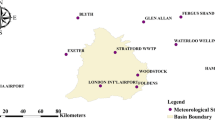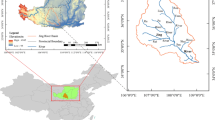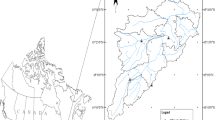Abstract
Weather generators are increasingly becoming viable alternate models to assess the effects of future climate change scenarios on water resources systems. In this study, a new multisite, multivariate maximum entropy bootstrap weather generator (MEBWG) is proposed for generating daily weather variables, which has the ability to mimic both, spatial and temporal dependence structure in addition to other historical statistics. The maximum entropy bootstrap (MEB) involves two main steps: (1) random sampling from the empirical cumulative distribution function with endpoints selected to allow limited extrapolation and (2) reordering of the random series to respect the rank ordering of the original time series (temporal dependence structure). To capture the multi-collinear structure between the weather variables and between the sites, we combine orthogonal linear transformation with MEB. Daily weather data, which include precipitation, maximum temperature and minimum temperature from 27 years of record from the Upper Thames River Basin in Ontario, Canada, are used to analyze the ability of MEBWG based weather generator. Results indicate that the statistics from the synthetic replicates were not significantly different from the observed data and the model is able to preserve the 27 CLIMDEX indices very well. The MEBWG model shows better performance in terms of extrapolation and computational efficiency when compared to multisite, multivariate K-nearest neighbour model.















Similar content being viewed by others
References
Apipattanavis S, Podestá G, Rajagopalan B, Katz RW (2007) A semiparametric multivariate and multisite weather generator. Water Resour Res 43(11). doi:10.1029/2006WR005714
Barbosa SM, Scotto MG, Alonso AM (2011) Summarising changes in air temperature over Central Europe by quantile regression and clustering. Nat Hazards Earth Syst Sci 3227–3233. doi:10.5194/nhess-11-3227-2011Buishand
Buishand TA, Brandsma T (2001) Multisite simulation of daily precipitation and temperature in the Rhine basin by nearest- neighbour resampling. Water Resour Res 37(11):2761–2776
Caron JM, O’Brien JJ (1998) The generation of synthetic sea surface temperature data for the equatorial Pacific Ocean. Am Meteorol Soc 126:2809–2821
Cook BI, Buckley BM (2009) Objective determination of monsoon season onset, withdrawal, and length. J Geophys Res 114(D23):D23109. doi:10.1029/2009JD012795
Cook ER, Palmer JG, Ahmed M, Woodhouse CA, Fenwick P, Zafar MU, Wahab M et al (2013) Five centuries of Upper Indus River flow from tree rings. J Hydrol 486:365–375. doi:10.1016/j.jhydrol.2013.02.004
Craigmile PF, Guttorp P (2011) Space–time modelling of trends in temperature series. J Time Ser Anal 32:378–395. doi:10.1111/j.1467-9892.2011.00733.x
Dreveton C, Guillou Y (2004) Use of a principal components analysis for the generation of daily time series. J Appl Meteorol 43:984–996
Elshamy ME, Wheater HS, Gedney N, Huntingford C (2006) Evaluation of the rainfall component of a weather generator for climate impact studies. J Hydrol 326:1–24. doi:10.1016/j.jhydrol.2005.09.017
Eum HI, Simonovic SP (2011) Assessment on variability of extreme climate events for the Upper Thames basin in Canada. Hydrol Process. doi:10.1002/hyp.8145
Eum HI, Sredojevic D, Simonovic SP (2011) Engineering input for the assessment of flood risk due to the climate change in the Upper Thames River Basin. J Hydrol Eng 16(7):608–612. doi:10.1061/(ASCE)HE.1943-5584.0000346
Hanson CL, Johnson GL (1998) GEM (generation of weather elements for multiple applications): its application in areas of complex terrain. Hydrol Water Resour Ecol Headwaters IAHS 248:27–32
Hauser T, Demirov E (2013) Development of a stochastic weather generator for the sub-polar North Atlantic. Stoch Environ Res Risk Assess. doi:10.1007/s00477-013-0688-z
Hundecha Y, Bardossy A (2008) Statistical downscaling of extremes of daily precipitation and temperature and construction of their future scenarios. Int J Climatol 610:589–610. doi:10.1002/joc
Keylock CJ (2012) A resampling method for generating synthetic hydrological time series with preservation of cross-correlative structure and higher-order properties. Water Resour Res 48(12). doi:10.1029/2012WR011923
Khazaei MR, Ahmadi S, Saghafian B, Zahabiyoun B (2013) A new daily weather generator to preserve extremes and low-frequency variability. Clim Change. doi:10.1007/s10584-013-0740-5
King LM, Mcleod AI, Simonovic SP (2012) Simulation of historical temperatures using a multi-site, multivariate block resampling algorithm with perturbation. Hydrol Process. doi:10.1002/hyp.9596
Kuchar L (2004) Using WGENK to generate synthetic daily weather data for modelling of agricultural processes. Math Comput Simul 65:69–75. doi:10.1016/j.matcom.2003.09.009
Lee T (2012) Serial dependence properties in multivariate streamflow simulation with independent decomposition analysis. 72. doi:10.1002/hyp.8177
Lee T, Ouarda TBMJ, Jeong C (2012) Nonparametric multivariate weather generator and an extreme value theory for bandwidth selection. J Hydrol 452–453:161–171
Li Z (2013) A new framework for multi-site weather generator: a two-stage model combining a parametric method with a distribution-free shuffle procedure. Clim Dyn. doi:10.1007/s00382-013-1979-2
Li Z, Liu WZ, Zhang XC, Zheng FL (2011) Assessing the site-specific impacts of climate change on hydrology, soil erosion and crop yields in the Loess Plateau of China. Clim Change 105:223–242
Prodanovic P, Simonovic SP (2008), Intensity duration frequency analysis under changing climatic conditions. In: Simonovic SP, Bourget P (eds) CD proceedings, 4th international symposium on flood defense: managing flood risk, reliability and vulnerability. Paper 142, 8 pages
Qian B, Gameda S, Hayhoe H, De Jong R, Bootsma A (2004) Comparison of LARS-WG and AAFC-WG stochastic weather generators for diverse Canadian climates. Clim Res 26:175–191. doi:10.3354/cr026175
Rajagopalan B, Lall U (1999) A k-nearest-neighbor simulator for daily precipitation and other weather variables. Water Resour Res 35(10):3089–3101
Semenov M (2008) Simulation of extreme events by a stochastic weather generator. Clim Res 35:203–212. doi:10.3354/cr00731
Semenov MA, Barrow EM (2002) LARS-WG: a stochastic weather generator for use in climate impact studies, version 3.0 user manual
Serinaldi F (2009) A multisite daily rainfall generator driven by bivariate copula-based mixed distributions. J Geophys Res 114:D10103. doi:10.1029/2008JD011258
Sharif M, Burn DH (2007) Improved k-nearest neighbor weather generating model. J Hydrol Eng 12(1):42–51
Sharif M, Burn DH, Hofbauer KM (2013) Generation of daily and hourly weather variables for use in climate change vulnerability assessment. Water Resour Manag 27(5):1533–1550. doi:10.1007/s11269-012-0253-4
Simonovic SP (2010) A new methodology for the assessment of climate change impacts on a watershed scale. Curr Sci 98(8):1047–1055
Smith TM, Reynolds RW, Livezey RE, Stokes DC (1996) Reconstruction of historical sea surface temperatures using empirical orthogonal functions. J Clim 9:1403–1420
Solaiman TA, King LM, Simonovic SP (2011) Extreme precipitation vulnerability in the Upper Thames River basin: uncertainty in climate model projections. Int J Climatol 31(15):2350–2364. doi:10.1002/joc.2244
Soltani A, Hoogenboom G (2003) Minimum data requirements for parameter estimation of stochastic weather generators. Clim Res 25:109–119
Vinod HD (2006) Maximum entropy ensembles for time series inference in economics. J Asian Econ 17(6):955–978. doi:10.1016/j.asieco.2006.09.001
Vinod HD, Lopez-de-Lacalle J (2009) Maximum entropy bootstrap for time series: the meboot R package. J Stat Softw 29(5):1–19
Westra S, Brown C, Lall U, Sharma A (2007) Modeling multivariable hydrological series: Principal component analysis or independent component analysis? Water Resour Res 43(6). doi:10.1029/2006WR005617
Wilby RL, Dawson CW (2007) SDSM 4.2—a decision support tool for the assessment of regional climate change impacts. Version 4.2 user manual
Wilks DS (1999) Multisite downscaling of daily precipitation with a stochastic weather generator. Clim Res 11:125–136
Wilks DS (2012) Stochastic weather generators for climate-change downscaling, part II: multivariable and spatially coherent multisite downscaling. Wiley Interdiscip Rev Clim Change 3(3):267–278
Wilks DS, Wilby RL (1999) The weather generation game: a review of stochastic weather models. Prog Phys Geogr 23(3):329–357. doi:10.1177/030913339902300302
World Climate Research Programme (WCRP) (2009) ETCCDI/CRD climate change indices: definitions of the 27 core indices. http://cccma.seos.uvic.ca/ETCCDI/list_27_indices.shtml. Accessed 4 Sept 2012
Yalta AY (2013) Revisiting the FDI-led growth hypothesis: the case of China. Econ Model 31:335–343. doi:10.1016/j.econmod.2012.11.030
Acknowledgments
The authors would like to acknowledge the financial support by the Natural Sciences and Engineering Research Council of Canada provided through the Discovery Grant to the second author. The authors would also like to thank Environment Canada for providing the climate data used in this research. We wish to acknowledge the effort put in by Prof. Zhu Li, the anonymous reviewer and the Executive Editor Jean-Claude Duplessy and thank them for their words of encouragement, good suggestions, and constructive comments.
Author information
Authors and Affiliations
Corresponding author
Appendix
Appendix
The following procedure presents a hypothetical example that illustrates the use of maximum entropy bootstrap (MEB) for generating a single replicate from the original time series. Table 3 and Fig. 16 provide details of the example in which rt and rgt represent original and generated series for a time period t = 1, 2, 3, …, 7. The steps in Table 1 are explained below.
-
1.
Sort the original time series (Table 3—Col. 2) in ascending order (Col. 4).
-
2.
Calculate the intermediate points, which is average between the consecutive values in Column 5 and are shown in Column 6.
-
3.
The upper (UL) and lower (LL) limiting values are calculates using Eqs. 9–11. Assuming 10 % trimming, we obtain LL = −3.67 and UL = 32.67. The uniform density is the combination of LL, intermediate points and UL as shown in Fig. 15.
-
4.
Calculate the desired means (Col. 6), using Eqs. 12–14, which ensures they satisfy the ergodic theorem.
-
5.
The quantiles of the maximum entropy density are computed by generate uniform random numbers between 0 and 1. This is shown in Column 7.
-
6.
Calculate the new values using maximum entropy density, as shown in Column 8.
-
7.
The replicate can be obtained by sorting Column 8 using the sorted order from Column 3.
It is evdient from the Fig. 16 that the MEB generated replicate is able to mimic the data pattern very well and hence the temporal and other statistics are well preserved.
Rights and permissions
About this article
Cite this article
Srivastav, R.K., Simonovic, S.P. Multi-site, multivariate weather generator using maximum entropy bootstrap. Clim Dyn 44, 3431–3448 (2015). https://doi.org/10.1007/s00382-014-2157-x
Received:
Accepted:
Published:
Issue Date:
DOI: https://doi.org/10.1007/s00382-014-2157-x





